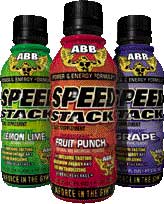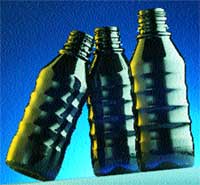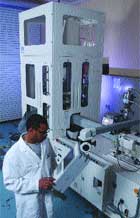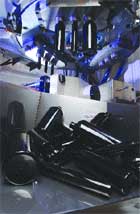January 29, 2014

The times they are a-changin' for bringing colored containers from concept stage to the consumer. Technological improvements cleverly applied could foster considerable expansion of tinted polyethylene terephthalate bottles, as technology could toss what had been a cumbersome developmental step out with the rejects.
The process involves making color chips as a prelude to blow molding the bottles. A new methodology, instituted exactly a year ago at the Suwanee, GA, technical center of colorant supplier PolyOne Corp., is assuring bottle molders an almost immediate color match that remains acceptable from trial run to full production. The marketer, or molder's customer, can then approve actual blow-molded bottles without going back to the molder again and again for adjustments.
|
Working in conjunction with an ultra-precise colorant blender, above, a new stretch/blow-molding machine slashes the time required to obtain exact specifications for PET bottles. Test bottles in three wall thicknesses, below, are blown simultaneously, showing colorant and carrier systems in their actual production environments, facilitating quick choices. |
|
Following 20 months of research before instituting the program, PolyOne is drawing the attention of several major molding firms intent on improving their container coloring capabilities (see sidebar). What draws their attention to Suwanee is PolyOne's installation of a specially configured Model 100LL-20 stretch/blow molder from Aoki Laboratory America; its quick-change tooling allows customers' prototype molds to be configured as needed.
Dramatic differences
Even more significantly, the unique molds produce bottles that, at a single shot, simultaneously yield three wall thicknesses, since the same colorant can result in dramatic differences in container hues. "Most color matching can be based on injection-molded trial chips," notes PolyOne marketing manager, PET packaging, Dan Martelli, "but there can be surprises when a molder moves from an approved color chip to production of blow-molded parts."
"Our understanding of PET in relation to colorants was greatly enhanced by the commissioning of our Aoki machine," PolyOne's technical center manager Gary Vernon explains. "Because the colorant and barrier systems are shown in their actual production environment, we're able to achieve color matches very quickly.
"We even found that we had been over-engineering, and that we can now get what the customer wants at a fraction of previous let-down ratios, saving money and helping to preserve the chemical and mechanical properties of the PET."
To help meet these criteria and reduce static electricity and resultant color clumping in the Aoki machine, PolyOne installed a Movacolor MC-24 doser from Romax. This machine, explains Romax president Eric Roberts, has a unique dosing-cylinder design that results in even, regular additive output through precisely adjustable stepper motors, and has the ability to store up to 99 additive parameters in its microprocessor memory. Another factor lending greater consistency to the mix, Martelli explains, is the use of a single PET resin, Eastman Chemical's 9921. "It matches the Aoki and Movacolor equipment as another top-of-the-line factor in our being able to present the customer with a premium-appearance container," he says.
Rapid match
Using these two machines permits production of sample bottles that rapidly match target production values. Once a color match at a target thickness is obtained, the other bottles in the shot reveal how production would look with different let-down ratios, showing light or dark targets without recalibration of the Aoki. Thus, a 20-mil bottle demonstrates the color double the let-down ratio of the 10-mil, and the 30-mil double the let-down of the 20-mil. Also specified is quick-change tooling, allowing customers to send their prototype molds and produce a three-bottle shot configured with the blow pins, cavity types and neck splits of their choice. "Our color rework," Martelli comments, "has gone down to practically zero. What changes we process now pretty much happen only when the customer sees the bottles in the specified color, then realizes it's not the ideal and changes the standard."
The search for the perfect color starts when the customer delivers the standard. It can be a Pantone® color chip, a design sample or a container–anything that visually or numerically sets the color to be met. PolyOne applies its Speed-e-Color® process via spectrophotometry to instrument the shade.
 If a standard color match doesn't exist, technicians turn to formulations that have worked in the past for similar applications and processing windows. As a final alternative, new formulations are developed, based on a company-wide knowledge base of colorants and compounds.
If a standard color match doesn't exist, technicians turn to formulations that have worked in the past for similar applications and processing windows. As a final alternative, new formulations are developed, based on a company-wide knowledge base of colorants and compounds.
Once a short list of candidates emerges, a 2-lb lot is produced and injection-molded using conventional chips. Any necessary tweaking is followed by production on the Movacolor/Aoki combination, with the customer able to review the results immediately and, in many cases, approve them for full production, it is reported.
Martelli contrasts the new procedure with the use of conventional color chips, noting: "With our Aoki-based method, customers can have confidence in the color and move to production in far less time, with much less back-and-forth with PolyOne. The color is right because it is based on the detailed knowledge we gather upfront about the needs of our customer.
"We engineer these colors individually, based upon the formulation attributes of the product, technical knowledge of the customer's process and our color-matching expertise. And the turnaround is dramatically shorter.
"We've done matches in days and have even matched colors that customers have struggled with for years," he adds. "We've gotten whites, blacks, reds, greens–colors that people don't believe. You bet they're happy."
More information is available:
Colorants: PolyOne Corp., 216/589-4000. Circle No. 208.
Stretch/blow molder: Aoki Laboratory America, 888/638-2323. Circle No. 209.
Doser: Romax, 502/327-8555. Circle No. 210.
Resin: Eastman Chemical, 800/327-8626. Circle No. 211.
A muscular equity builds |
For Alex Parker, director of manufacturing development at Weider Nutrition Intl. of Salt Lake City, it's a matter of trying ideas. And "jet-black" colorant works. That's why, in January, Weider tossed out eight different colored polystyrene bottles in favor of three sizes of polyethylene terephthalate containers for its 27-flavor series of American Body Building protein-based drinks that combine to make it the top-seller in gym/healthclub distribution. The jet-black containers in 18-, 22- and 24-oz quantities are actually lower-priced than the corresponding PS bottles Weider was using for the last decade, notes Parker. "And they do a better job of reaching body builders and unifying the line with a single powerful image," he adds. |
About the Author(s)
You May Also Like




